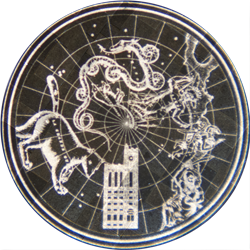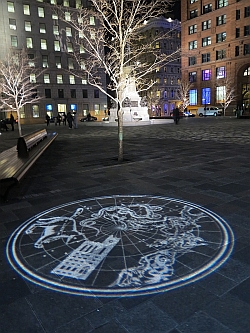



|
|||
| Viewing Times | Polaris can be viewed on any clear night, preferably when the moon is not full. | ||
| Each night a 19th century star map is projected onto the pavement of Place d'Armes. |

|
||
|
The star map displays Montreal's first office tower, a red sandstone building completed in 1888, and above it, Polaris, the pivot around which the stars of the northern hemisphere appear to move. |
|||
 |
|||
|
A paving stone with an engraved star 7 meters from the projection indicates the exact position to view the alignment. |
|||
 |
|||
Read more ...Polaris is located almost directly above the Earth's North Pole. Due to a slight offset from truth north, Polaris describes a small circle around the North Celestial Pole as the Earth rotates. This is the pivot around which the stars of the northern hemisphere appear to move. Polaris forms the tip of the tail of Ursa Minor-the Little Bear-also known as the Little Dipper. A yellow supergiant situated approximately 700 light-years from the Earth, Polaris has a diameter almost 70 times that of the Sun and shines 5,500 times brighter.
Polaris has not always been the North Star. As the Earth spins on its axis it wobbles in a slow circular motion like a child's top. This is called precession and means that the Earth's North Pole points to different stars over a 26,000 year period. In 2,800 B.C. when the Egyptians were building the pyramids, the North Celestial Pole was near the star Thuban in the constellation of Draco, the dragon. When Julius Caesar ruled the Roman Empire in the first century BCE, the North Celestial Pole was between the star Merak in Ursa Minor and Polaris. In 12,000 years from now it will be near the bright star Vega in the constellation of Lyra, the harp.
|
|||
 |
|||

|

See full website for detailed credits.
© Alison Tett, 2012. Website - Elliot Selick